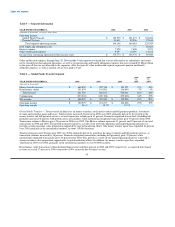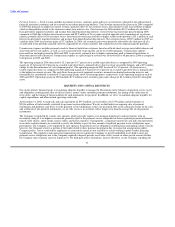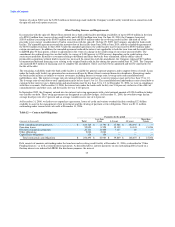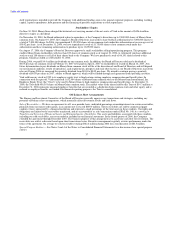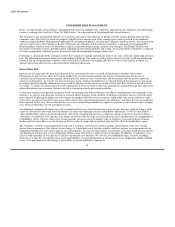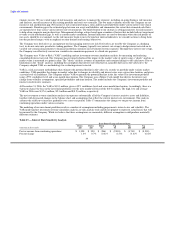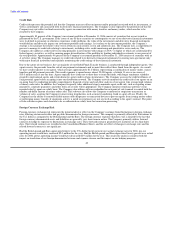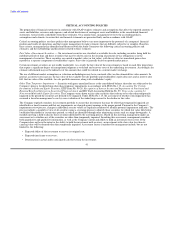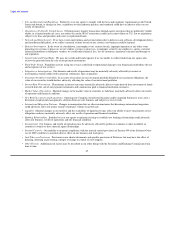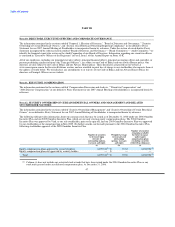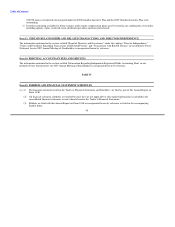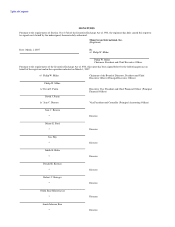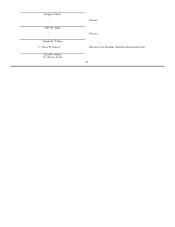MoneyGram 2006 Annual Report Download - page 43
Download and view the complete annual report
Please find page 43 of the 2006 MoneyGram annual report below. You can navigate through the pages in the report by either clicking on the pages listed below, or by using the keyword search tool below to find specific information within the annual report.
Table of Contents
Credit Risk
Credit risk represents the potential risk that the Company may not collect on interest and/or principal associated with its investments, as
well as counterparty risk associated with its derivative financial instruments. The Company is also exposed to the potential risk that the
Company may not collect on funds received by agents in connection with money transfers and money orders, which are due to be
remitted to the Company.
Approximately 89 percent of the Company's investment portfolio at December 31, 2006 consists of securities that are not issued or
guaranteed by the U.S. government. If the issuer of any of these securities or counterparties to any of our derivative financial instruments
were to default in payments or otherwise experience credit problems, the value of the investments and derivative financial instruments
would decline and adversely impact our investment portfolio and earnings. As it relates to the investment portfolio, the Company's
strategy is to maximize the relative value versus return on each security, sector and collateral class. The Company uses a comprehensive
process to manage its credit risk relating to investments, including active credit monitoring and quantitative sector analysis. The
Company also addresses credit risk by investing primarily in investments with ratings of A3/A− or higher or which are collateralized by
federal agency securities, as well as ensuring proper diversification of the portfolio by limiting individual investments to one percent of
the total portfolio. Approximately 96 percent of the Company's investment portfolio at December 31, 2006 consists of securities with an
A or better rating. The Company manages its credit risk related to its derivative financial instruments by entering into agreements only
with major financial institutions and regularly monitoring the credit ratings of these financial institutions.
Due to the nature of our business, the vast majority of our Global Funds Transfer business is conducted through independent agents. Our
agents receive the proceeds from the sale of our payment instruments and we must then collect these funds from the agents. As a result,
we have credit exposure to our agents, which averages approximately $1.2 billion, representing a combination of money orders, money
transfers and bill payment proceeds. This credit exposure is spread across almost 29,000 agents, of which 13 owe us in excess of
$15.0 million each at any one time. Agents typically have from one to three days to remit the funds, with longer remittance schedules
granted to international agents and certain domestic agents under certain circumstances. The Company assesses the creditworthiness of
each potential agent before accepting it into our distribution network. The Company actively monitors the credit risk of our agents on an
on-going basis by conducting periodic comprehensive financial reviews and cash flow analysis of our agents who average high volumes
of money order sales. In addition, the Company frequently takes additional steps to minimize agent credit risk, such as requiring owner
guarantees, corporate guarantees and other forms of security where appropriate. The Company monitors remittance patterns versus
reported sales by agent on a daily basis. The Company also utilizes software embedded in each point of sale terminal to control both the
number and dollar amount of money orders sold. This software also allows the Company to monitor for suspicious transactions or
volumes of sales, assisting the Company in uncovering irregularities such as money laundering, fraud or agent self-use. Finally, the
Company has the ability to remotely disable money order dispensers or transaction devices to prevent agents from issuing money orders
or performing money transfers if suspicious activity is noted or remittances are not received according to the agent's contract. The point
of sale software requires each location to be re-authorized on a daily basis for transaction processing.
Foreign Currency Exchange Risk
Foreign currency exchange risk represents the potential adverse effect on the Company's earnings from fluctuations in foreign exchange
rates affecting certain receivables and payables denominated in foreign currencies. The company is primarily affected by fluctuations in
the U.S. dollar as compared to the British pound and the Euro. The foreign currency exposure that does exist is limited by the fact that
foreign currency denominated assets and liabilities are generally very short-term in nature. The Company primarily utilizes forward
contracts to hedge its exposure to fluctuations in exchange rates. These forward contracts generally have maturities of less than thirty
days. The forward contracts are recorded on the Consolidated Balance Sheets, and the net effect of changes in exchange rates and the
related forward contracts is not significant.
Had the British pound and Euro appreciated relative to the U.S. dollar twenty percent over actual exchange rates for 2006, pre-tax
operating income would have increased $2.0 million for the year. Had the British pound and Euro depreciated twenty percent over actual
rates for 2006, pretax operating income would have decreased $2.9 million for the year. This sensitivity analysis considers both the
impact on translation of our foreign denominated revenue and expense streams and the impact on our hedging program.
40


